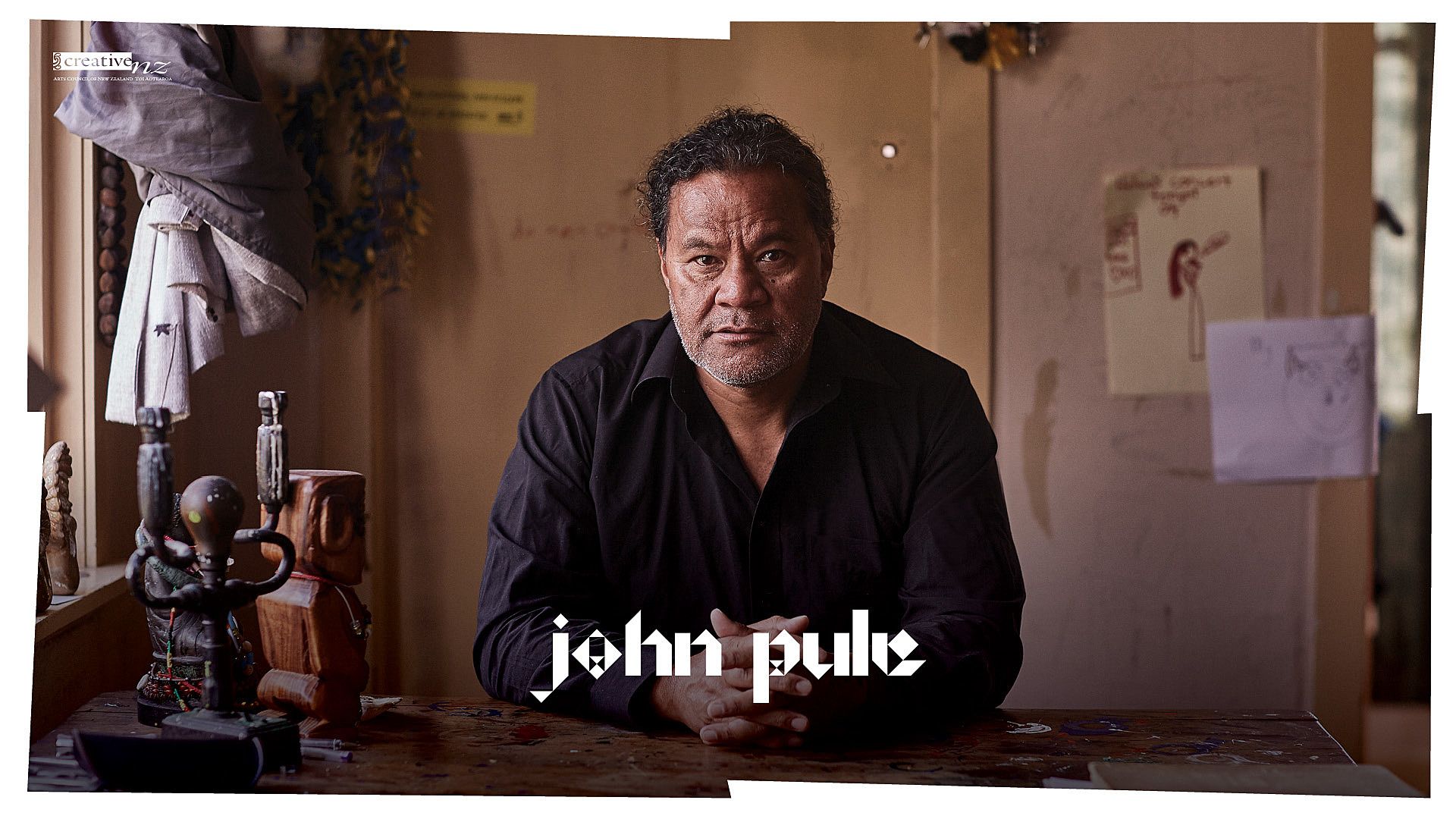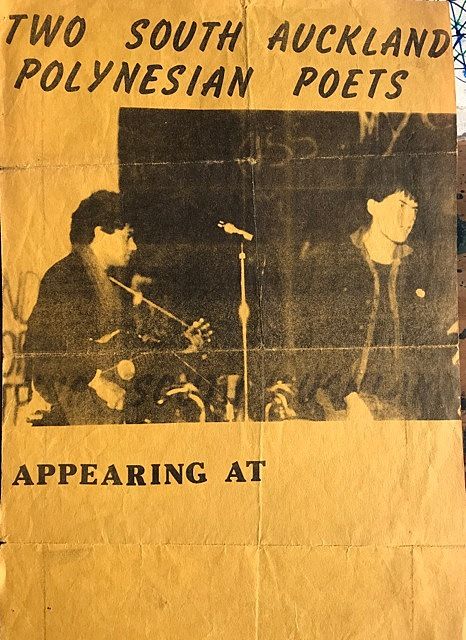Walking on the Paepae
John Pule shares with us his life before painting, reading words strangely arranged on pages in his family’s state house in Ōtara, and finding poetry in unexpected places.
We’re collaborating with Creative New Zealand to bring you the groundbreaking Pacific Arts Legacy Project. Curated by Lana Lopesi as project Editor-in-Chief, it’s a foundational history of Pacific arts in Aotearoa as told from the perspective of the artists who were there.
1980 was a significant year for me. I lived in a state house in Ōtara and my family were fans of the then big-format New Zealand Listener. It was inside this magazine that I found strangely arranged words in the opening pages. Folks called this poetry and the folks who wrote it were called poets.
I took an interest in the way so few words can be used to explain big themes. I remember the poets I first read, Hone Tuwhare, Elizabeth Smither, Michael Harlow and many others. So I wrote, imitating the formats. And eventually I bought a cheap typewriter, visited second-hand bookshops and soon had a small collection of books by mainly European poets. I knew from an early age I was born in Niue and came from across the Pacific Ocean to settle in Tāmaki Makaurau with my parents and sisters. I knew we lived in houses especially designed and built for low-income earners; this was after we spent time living in Grey Lynn. I knew that the industrial factories were built around the state houses of Ōtara to make it easier for labourers to commute.
I knew from an early age I was born in Niue and came from across the Pacific Ocean to settle in Tāmaki Makaurau with my parents and sisters
I worked in the factories and abattoirs with my uncles, friends and cousins. These experiences didn’t seep into my early poems, however. Rather, what interested me most was the romance associated with the islands. This prompted me to understand where I was from and to know what I longed for. I began lifelong research by talking to two women who influenced the way I collected imagery from home: my mother, Atatupe Loata Lohana, and my aunty, my father’s eldest sister, Moka Famu Falenogi. From the images I collected from these two teachers I was able to write.
you are the one fruit in my soul
you sometimes blossom in winter
but it is spring when you beautify the horizon
the clouds rise triumphantly
at night a nocturne of waves sad from its internal sound
awoke me, though I live far from its grief
I remember the direction you left on
Sounds that could only come from you echoed through
The pineapples, and to have seen you in lavalava
The fire of Polynesia, I would take you to
My mother’s country where hibiscus flowers
Tip their pollen into canoes
Drifting out to sea
My early influences were European poets such John Keats, William Wordsworth, Percy Bysshe Shelley, Elizabeth Barrett Browning, Charles Baudelaire, Anna Akhmatova, Comte de Lautréamont, Arthur Rimbaud, Vladimir Mayakovsky, and later Pablo Neruda and Vicente Huidobro.
I came across the Poetry Live nights at the Globe Tavern in 1980, and instantly came face to face with a milieu that I had only read about in that European literature I encountered. For a brief few months I found myself as the only Islander in these readings, held every Tuesday and MC’d by poet David Mitchell. Then one night I was confronted with a sight that blew me away. The young man on stage, shirtless, performing a Sāmoan slap dance to a musical beat I recognised as a Talking Heads tune coming from a cheap tape recorder, I think the tune was Once in a Lifetime. Albert Livingstone Refiti was his name, and we struck a friendship that remains to this day. We discussed much subject matter relating to poetry and architecture in the Pacific, and besides that he introduced me to stretching canvas on old window frames. We were new to this idea of what could be Pacific art and poetry. We had never heard of or come across what was happening in the University of the South Pacific at the time.
Image courtesy of John Pule
Image courtesy of John Pule
I think we were elated to know that we were not alone in this world of the Globe. I read my first poems at the Globe. For the first time I was not alone, there were others like myself, even though they were Pākehā, they did not question me, they just knew I was from Niue. I met many poets and artists, actors and writers. Tony Fomison, Emily (Emare) Karaka, Gary Mutton, Maurice Shadbolt, Bruno Lawrence, Rowley Habib, Bob Orr, Roma Potiki, Sandra Bell, David Eggleton, Hilary Baxter, Stephen Oliver, Brian Gregory, Micheal O’Leary, Barry Metcalf and many others.
1981 to 1983, I joined the marches against apartheid and was part of the Springbok Tour protests at Eden Park. It was my first awareness of racism and that Black was a colour that in other countries got you killed. This was a catalyst for my poetry, which became political for a number of years.
Black is the colour in our dreams/black is the colour of reality/where are your
children/shot and bandaged by blood/their hands raised in protest/many are pulled
down sad/from years of oppression/they flee from bullets/the crushed hills signify
their lament/earth, poor mother, is barren and spits out every coffin because of the
white death/where are your children/weaned from your breasts/segregated from
sleepless dogs/licked from your arms/hungry in your voice/shot in your
hands/buried before your eyes/mothers/what burden you carry/your sons
and daughters lie wounded at the door/cast your eyes down/look at what you have
done/look at the fields you gave/tired/broken as the people/rotten corn/black
wheat/tasteless maize/dark water/huts shattered by guns/the streets smell of
hate/every window embraced by death/despite guns between sky and
ocean/despite walking in hate/despite being batoned to the ground/they shall go on
living
Pacific art was still not yet fully developed. By 1983 we had the likes of Ioane Ioane, Lily Laita, Sale Jessop, and many others soon followed, appearing on the scene. I remember an exhibition by Fatu Feuʻu upstairs at the Polynesian Bookshop when it was situated at Three Lamps. He had not yet discovered what he is now known for, his paintings were more related to American painter Jackson Pollock – splashes of monotone whites and greys. The South Pacific Arts Council was still maturing.
I started to do poetry tours; one with musician Paul Luker and another with poets Mike Johnson and Leila Lees. David Eggleton and I called ourselves the Two South Auckland Polynesian Poets and toured New Zealand during Orientation Week, opening two shows for Herbs. But it was several events that influenced my writings during these first three years. Patu!, the 1983 film that was Merata Mita’s record of the protests against the visiting Springbok rugby team; listening to the Kenyan writer Ngũgĩ wa Thiong’o speak at the University of Auckland; and also Eggleton and myself being invited by Roma Potiki to take part in a series of readings called Māori Writers Read, over Labour Weekend in Wellington. The event was meant to financially support the publications by two Māori writers: The Bone People by Keri Hulme, and House of the Talking Cat, a collection of short stories by J C Sturm. It was there I meet Witi Ihimaera, Apirana Taylor, Patricia Grace, Alistair Campbell, Carmel Peteru and many others. For the first time I was immersed in the ‘sometime’ that told me I was walking on the paepae.
I know of a shore glistening in the islands,
Where the sun, resplendent in clouds, also ripples
Upon the sensuous sands, and the muscadine of
Crushed grapes would astonish exotic lands, where
The pheasant, a flaming paradise, relinquish
Its lush colours in praise to the pacific beauty.
Frangipanis leaning into the constellation Swan
Spread pollen into her lakes, while at dusk,
Young lovers, after celebrating, drift in canoes
Garlanded with hibiscus, under vermilion horizons,
Played upon by winds, following the albatross out to silent seas.
And the island, when I dream of its solitary bays,
Eating mangoes under shady palm trees,
Enhances migrant dolphins crossing the equator.
cnz logo
This piece is published in collaboration with Creative New Zealand as part of the Pacific Arts Legacy Project, an initiative under Creative New Zealand’s Pacific Arts Strategy. Lana Lopesi is Editor-in-Chief of the project.
Feature image credit: Tobias Kraus




